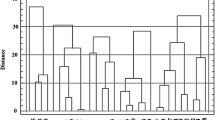Abstract
Methods for the isolation of cytoplasts from suspension culture-derived protoplasts of the monocot Lolium perenne (perennial ryegrass) and the dicot Beta vulgaris (sugarbeet) have been determined. After comparing a range of gradients it was found that a discontinuous sucrose/mannitol gradient gave the highest cytoplast yields for both species tested: of the protoplasts loaded onto the gradient, for Beta >30% and for Lolium up to 45% could be recovered as cytoplasts. Sufficient protoplasts could be loaded onto the gradient to produce suitable numbers of cytoplasts for use in asymmetric somatic hybridisation experiments. Cytoplasts could be isolated from several suspension cultures of different ages. The cytoplast fraction was recovered from the upper part of the gradient in all cases and was only slightly contaminated (2–8%) with protoplasts. Lolium cytoplasts were small, evacuolate cells with granular cytoplasm. In contrast, Beta cytoplasts were larger and predominantly vacuolate. Both contained mitochondria as determined using fluorescence staining.
Similar content being viewed by others
Abbreviations
- 2,4-d :
-
2,4 dichlorophenoxyacetic acid
- M:
-
mannitol
- S:
-
sucrose
- P:
-
Percoll
- S/M:
-
sucrose/mannitol gradient
References
Archer, EK, Landgren, CR & Bonnet, HT (1982) Cytoplast formation and enrichment from mesophyll tissues of Nicotiana spp. Plant Sci. Lett. 25: 175–185
Bradley, PM (1978) Production of enucleated plant protoplasts of Allium cepa. Plant Sci. Lett. 13: 287–290
Coleman, AW & Goff, LJ (1985) Application of fluorochromes to pollen biology. I. Mithramycin and 4′,6-diaminidino-2-phenylindole (DAPI) as vital stains and for quantitation of nuclear DNA. Stain Technol. 60: 145–154
Creemers-Molenaar, J, van der Valk, P, Loeffen, JPM & Zaal, MACM (1989) Plant regeneration from suspension cultures and protoplasts of Lolium perenne L. Plant Science 63: 167–176
Dalton, SJ (1988) Plant regeneration from cell suspension protoplasts of Festuca arundinacea Schreb., Lolium perenne L. and L. multiflorum Lam. Plant Cell Tiss. Org. Cult. 12: 137–140
Famelaer, I, Negrutiu, I, Monras, A, Vaucheret, H & Jacobs, M (1990) Asymmetric hybridisation in Nicotiana by ‘gamma fusion’ and progeny analysis of self-fertile hybrids. Theor. Appl. Genet. 79: 513–520
Frearson, EM, Power, JB & Cocking, EC (1973) The isolation, culture and regeneration of Petunia leaf protoplasts. Developmental Biol. 33: 130–137
De Greef, W & Jacobs, MK (1979) In vitro culture of the sugarbeet: description of a cell line with high regeneration capacity. Plant Science 17: 55–61
Griesbach, RJ & Sink, KC (1983) Evacuolation of mesophyll protoplasts. Plant Sci. Lett. 30: 297–301
Gwórdz, EA & Waliszewska, B (1979) Regeneration of enzymatically isolated protoplasts of the moss Funaria hygrometrica L. Sibth. Plant Sci. Lett. 15: 41–45
Hall, RD & Krens, FA (1988) The production and electrofusion of Beta cytoplasts. In: Puite, KJ, Dons, JJM, Huizing, HF, Kool, AJ, Koornneef, M & Krens, FA (Eds) Progress in Plant Protoplast Research (pp 263–264). Kluwer Academic Publishers Dordrecht/Boston/London
Harms, CT & Potrykus, I (1978) Fractionation of plant protoplast types by iso-osmotic density gradient centrifugation. Theor. Appl. Gent. 53: 57–63
Krens, FA, Jamar, D, Rouwendal, GJA, Hall, RD (1990) Transfer of cytoplasm from new Beta CMS sources to sugarbeet by asymmetric fusion. I. Shoot regeneration from mesophyll protoplasts and characterization of regenerated plants. Theor. Appl. Genet. 79: 390–396
Lesney, MS, Callon, PW & Sink, KC (1986) A technique for bulk production of cytoplasts and miniprotoplasts from suspension culture derived protoplasts. Plant Cell Rep. 5: 115–118
Lörz, H, Paszkowski, J, Dierks-Ventling, C & Potrykus, I (1981) Isolation and characterization of cytoplasts and miniprotoplasts derived from protoplasts of cultured cells. Physiol. Plant. 53: 385–391
maliga, P, Lörz, H, Lázár, G & Nagy, F (1982) Cytoplastprotoplast fusion for interspecific chloroplast transfer in Nicotiana. Mol. Genet. 185: 211–215
Matzke, MA & Matzke, AJM (1986) Visualisation of mitochondria and nuclei in living plant cells by the use of a potential-sensitive fluorescent dye. Plant Cell Environ. 9: 73–77
melzer, JM & O'Connell, MA (1990) Molecular analysis of the extent of asymmetry in the asymmetric somatic hybrids of tomato. Theor. Appl. Genet. 79: 193–200
Roest, S & Gilissen, LJW (1989) Plant regeneration from protoplasts: A literature review. Acta Bot. Neerl. 38: 1–23
Sakai, T & Imamura, J (1990) Intergenetic transfer of cytoplasmic male sterility between Raphanus sativus (CMS line) and Brassica napus through cytoplast-protoplast fusion. Theor. Appl. Genet. 80: 421–427
Saunders, JW & Doley, WP (1986) One step shoot regeneration from callus of whole plant leaf explants of sugarbeet lines and a somaclonal variant for in vitro behaviour. J. Plant Physiol. 124: 473–479
Wallin, A, Glimelius, K & Eriksson, T (1978) Enucleation of plant protoplasts by Cytochalasin B. Z. Pflanzenphysiol. 87: 333–340
Watanabe, M & Yamaguchi, H (1988) The methods for isolation of cytoplasts in several crop plants. Japan. J. Breed. 38: 43–52
Wichers, HJ, ten Kate, J, Buys, CHCM & Huizing, HJ (1984) A simple and rapid method procedure to obtain nucleated protoplasts from plant material. Cytologia 49: 529–535
Widholm, JM (1972) The use of fluorescein diacetate and phenosafranine for determining viability of cultured plant cells. Stain Technology 47: 189–194
Wijbrandi, J, Zabel, P & Koornneef, M (1990) Restriction fragment length polymorphism analysis of somatic hybrids between Lycopersicon esculentum and irradiated L. peruvianum: Evidence for limitead donor genome elimination and extensive chromosome rearrangements. Mol. Gen. Genet. 222: 270–277
Author information
Authors and Affiliations
Rights and permissions
About this article
Cite this article
van Ark, H.F., Hall, R.D., Creemers-Molenaar, J. et al. High yields of cytoplasts from protoplasts of Lolium perenne and Beta vulgaris using gradient centrifugation. Plant Cell Tiss Organ Cult 31, 223–232 (1992). https://doi.org/10.1007/BF00036228
Received:
Accepted:
Issue Date:
DOI: https://doi.org/10.1007/BF00036228




